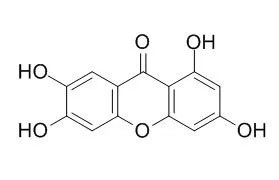| Pharm Biol. 2014 Jan;52(1):68-73. |
| Mangiferin and its aglycone, norathyriol, improve glucose metabolism by activation of AMP-activated protein kinase.[Pubmed: 24033319] |
Mangiferin has been reported to possess antidiabetic activities. Norathyriol, a xanthone aglycone, has the same structure as mangiferin, except for a C-glucosyl bond. To our best knowledge, no study has been conducted to determine and compare those two compounds on glucose consumption in vitro. In this study, the effects of Norathyriol and mangiferin on glucose consumption in normal and insulin resistance (IR) L6 myotubes were evaluated. Simultaneously, the potential mechanism of this effect was also investigated.
METHODS AND RESULTS:
Normal or IR L6 myotubes were incubated with Norathyriol (2.5 ∼ 10 μM, 0.625 ∼ 2.5 μM), mangiferin (10 ∼ 40 μM, 2.5 ∼ 10 μM) or rosiglitazone (20 μM) and/or 0.05 nM insulin for 24 h, respectively. The glucose consumption was assessed using the glucose oxidase method. Immunoblotting was performed to detect protein kinase B (PKB/Akt) and AMP-activated protein kinase (AMPK) phosphorylation in L6 myotubes cells. Norathyriol and mangiferin treatment alone increased the glucose consumption 61.9 and 56.3%, respectively, in L6 myotubes and made additional increasing with 0.05 nM insulin. In IR L6 myotubes, Norathyriol treatment made increasing with or without insulin, mangiferin treatment also made increasing but only when co-treated with insulin. Immunoblotting results showed that Norathyriol and mangiferin produced an increase of 1.9 - and 1.8-fold in the phosphorylation levels of the AMPK, but not in Akt.
CONCLUSIONS:
Our findings suggest that Norathyriol and mangiferin could improve the glucose utilization and insulin sensitivity by up-regulation of the phosphorylation of AMPK. Norathyriol may be considered as an active metabolite responsible for the antidiabetic activity of mangiferin. |
| J Cancer Res Ther. 2012 Oct-Dec;8(4):561-4. |
| Norathyriol suppresses transformation in JB6 P+ cells by the inhibition of Akt.[Pubmed: 23361275] |
Chemoprevention has been acknowledged as an important and practical strategy for the management of skin cancer. Norathyriol, a naturally occurring compound present in various plants, has a potent anticancer-promoting activity.The aim was to investigate the chemopreventive activity of Norathyriol on JB6 P+ cells.
METHODS AND RESULTS:
A soft agar assay was used to detect the effect of Norathyriol on cell transformation. The activator protein-1 (AP-1) transactivation activity was examined by the luciferase assay. Norathyriol inhibited epidermal growth factor (EGF)- and 12-O-tetradecanoylphorbol-13-acetate (TPA)-induced neoplastic cell transformation in a dose-dependent manner. The activation of activator protein-1 was dose dependently suppressed by Norathyriol treatment. Western blot data revealed that Norathyriol attenuated the phosphorylation of Akt.
CONCLUSIONS:
Norathyriol exerts a potent chemopreventive activity by inhibiting Akt activation in neoplastic cell transformation. |
| Cancer Res. 2012 Jan 1;72(1):260-70. |
| Norathyriol suppresses skin cancers induced by solar ultraviolet radiation by targeting ERK kinases.[Pubmed: 22084399] |
Ultraviolet (UV) irradiation is the leading factor in the development of skin cancer, prompting great interest in chemopreventive agents for this disease.
METHODS AND RESULTS:
In this study, we report the discovery of Norathyriol, a plant-derived chemopreventive compound identified through an in silico virtual screening of the Chinese Medicine Library. Norathyriol is a metabolite of mangiferin found in mango, Hypericum elegans, and Tripterospermum lanceolatum and is known to have anticancer activity. Mechanistic investigations determined that Norathyriol acted as an inhibitor of extracellular signal-regulated kinase (ERK)1/2 activity to attenuate UVB-induced phosphorylation in mitogen-activated protein kinases signaling cascades. We confirmed the direct and specific binding of Norathyriol with ERK2 through a cocrystal structural analysis. The xanthone moiety in Norathyriol acted as an adenine mimetic to anchor the compound by hydrogen bonds to the hinge region of the protein ATP-binding site on ERK2. Norathyriol inhibited in vitro cell growth in mouse skin epidermal JB6 P+ cells at the level of G(2)-M phase arrest. In mouse skin tumorigenesis assays, Norathyriol significantly suppressed solar UV-induced skin carcinogenesis. Further analysis indicated that Norathyriol mediates its chemopreventive activity by inhibiting the ERK-dependent activity of transcriptional factors AP-1 and NF-κB during UV-induced skin carcinogenesis.
CONCLUSIONS:
Taken together, our results identify Norathyriol as a safe new chemopreventive agent that is highly effective against development of UV-induced skin cancer. |
| Eur J Pharmacol. 1991 Jan 3;192(1):133-9. |
| Vasorelaxation of rat thoracic aorta caused by norathyriol isolated from Gentianaceae.[Pubmed: 1645671] |
The pharmacological effects of Norathyriol on isolated rat thoracic aorta were examined.
METHODS AND RESULTS:
In the high-K+ (60 mM) medium, Ca2+ (0.03 to 3 mM)-induced vasocontraction was inhibited concentration dependently by Norathyriol. Given as pretreatment Norathyriol (20 to 200 microM) also inhibited the norepinephrine (NE, 3 microM)-induced tonic contraction. However, the phasic contraction was inhibited only by high concentrations of Norathyriol (200 and 400 microM). The tonic contraction elicited by NE was also relaxed by the addition of Norathyriol. This relaxing effect of Norathyriol was not antagonized by methylene blue (50 microM) or indomethacin (20 microM) and was still seen in denuded rat aorta. Although the cAMP level was not changed by Norathyriol, the cGMP level was increased by a high concentration of Norathyriol (400 microM). [3H]Inositol monophosphate formation caused by NE was not affected by Norathyriol at concentration of either 100 or 400 microM. The 45Ca2+ influx caused by either NE or high K+ was inhibited by Norathyriol in a concentration-dependent manner.
CONCLUSIONS:
It is concluded that Norathyriol relaxed the rat thoracic aorta mainly by suppressing the Ca2+ influx through both voltage-dependent and receptor-operated calcium channels. |






 Cell. 2018 Jan 11;172(1-2):249-261.e12. doi: 10.1016/j.cell.2017.12.019.IF=36.216(2019)
Cell. 2018 Jan 11;172(1-2):249-261.e12. doi: 10.1016/j.cell.2017.12.019.IF=36.216(2019) Cell Metab. 2020 Mar 3;31(3):534-548.e5. doi: 10.1016/j.cmet.2020.01.002.IF=22.415(2019)
Cell Metab. 2020 Mar 3;31(3):534-548.e5. doi: 10.1016/j.cmet.2020.01.002.IF=22.415(2019) Mol Cell. 2017 Nov 16;68(4):673-685.e6. doi: 10.1016/j.molcel.2017.10.022.IF=14.548(2019)
Mol Cell. 2017 Nov 16;68(4):673-685.e6. doi: 10.1016/j.molcel.2017.10.022.IF=14.548(2019)